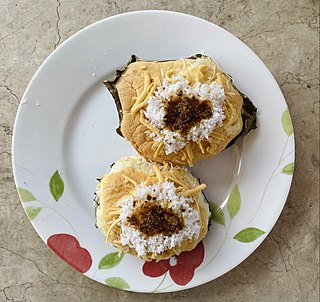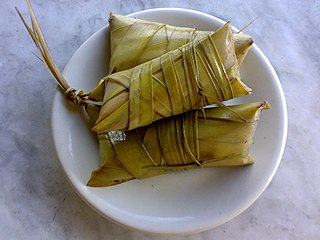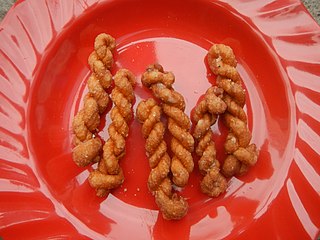Related Research Articles

Glutinous rice is a type of rice grown mainly in Southeast and East Asia, and the northeastern regions of South Asia, which has opaque grains, very low amylose content, and is especially sticky when cooked. It is widely consumed across Asia.

Filipino cuisine is composed of the cuisines of more than a hundred distinct ethnolinguistic groups found throughout the Philippine archipelago. A majority of mainstream Filipino dishes that compose Filipino cuisine are from the food traditions of various ethnolinguistic groups and tribes of the archipelago, including the Ilocano, Pangasinan, Kapampangan, Tagalog, Bicolano, Visayan, Chavacano and Maranao ethnolinguistic groups. The styles of preparation and dishes associated with them have evolved over many centuries from a largely indigenous base shared with maritime Southeast Asia with varied influences from Chinese, Spanish and American cuisines, in line with the major waves of influence that had enriched the cultures of the archipelago, as well as others adapted to indigenous ingredients and the local palate.

Bibingka commonly refers to a type of baked rice cake from the Philippines that is traditionally cooked in a terracotta oven lined with banana leaves and is usually eaten for breakfast or as merienda especially during the Christmas season.

A rice cake may be any kind of food item made from rice that has been shaped, condensed, or otherwise combined into a single object. A wide variety of rice cakes exist in many different cultures in which rice is eaten and are particularly prevalent in Japan. Common variations include cakes made with rice flour, those made from ground rice, and those made from whole grains of rice compressed together or combined with some other binding substance.

Tapai is a traditional fermented preparation of rice or other starchy foods, and is found throughout much of Southeast Asia, especially in Austronesian cultures, and parts of East Asia. It refers to both the alcoholic paste and the alcoholic beverage derived from it. It has a sweet or sour taste and can be eaten as is, as ingredients for traditional recipes, or fermented further to make rice wine. Tapai is traditionally made with white rice or glutinous rice, but can also be made from a variety of carbohydrate sources, including cassava and potatoes. Fermentation is performed by a variety of moulds including Aspergillus oryzae, Rhizopus oryzae, Amylomyces rouxii or Mucor species, and yeasts including Saccharomyces cerevisiae, and Saccharomycopsis fibuliger, Endomycopsis burtonii and others, along with bacteria.

Suman or budbud is a rice cake originating in the Philippines. It is made from glutinous rice cooked in coconut milk, often wrapped in banana leaves, coconut leaves, or buli or buri palm (Corypha) leaves for steaming. It is usually eaten sprinkled with sugar or laden with latik. A widespread variant of suman uses cassava instead of glutinous rice.

Kalamay, is a sticky sweet delicacy that is popular in many regions of the Philippines. It is made of coconut milk, brown sugar, and ground glutinous rice. It can also be flavored with margarine, peanut butter, or vanilla. Kalamay can be eaten alone but is usually used as a sweetener for a number of Filipino desserts and beverages. It is related to the Chamorro dessert called Kalamai.

Puto is a Filipino steamed rice cake, traditionally made from slightly fermented rice dough (galapong). It is eaten as is or as an accompaniment to a number of savoury dishes. Puto is also an umbrella term for various kinds of indigenous steamed cakes, including those made without rice. It is a sub-type of kakanin.

Puto seco, also known as puto masa, are Filipino cookies made from ground glutinous rice, cornstarch, sugar, salt, butter, and eggs. They are characteristically white and often shaped into thick disks. They have a dry, powdery texture.

Kue putu or putu bambu is an Indonesian kue. It is made of rice flour called suji and coloured green with pandan leaves, filled with palm sugar, steamed in bamboo tubes, and served with desiccated coconut. This traditional bite-sized snack is commonly found in maritime Southeast Asia, particularly in Java, Indonesia, where it is called putu bumbung. Kue putu is usually sold by street vendors and can be found in traditional markets, along with other kues. Kue putu can also be found in the Netherlands due to its colonial ties with Indonesia.

Pichi-pichi, also spelled pitsi-pitsi, is a Filipino dessert made from steamed cassava flour balls mixed with sugar and lye. It is also commonly flavored with pandan leaves. It is served rolled in freshly grated coconut, cheese, or latik before serving.

Ube halaya or halayang ube is a Philippine dessert made from boiled and mashed purple yam. Ube halaya is the main base in ube/purple yam flavored-pastries and ice cream. It can also be incorporated in other desserts such as halo-halo. It is also commonly anglicized as ube jam, or called by its original native name, nilupak na ube.

Biko is a sweet rice cake from the Philippines. It is made of coconut milk, brown sugar, ginger, and glutinous rice. It is usually topped with latik. It is a type of kalamay dish and is prepared similarly, except the rice grains are not ground into a paste. They are also sometimes packaged and sold as suman.

In Filipino cuisine, moron is a rice cake similar to suman. It is a native delicacy of the Waray people in the Eastern Visayas region of the Philippines, particularly in the area around Tacloban City in the province of Leyte and in Eastern Samar province. Other parts of the Philippines have their versions of it, however. In fact, the moron was adopted as one of Mambajao, Camiguin's locally produced products.

Salukara is a type of pancake of the Waray people in Eastern Samar, Philippines. It is made with galapong, coconut milk, sugar, and water, the same ingredients to make the cake called bibingka. Traditionally tubâ is used as the leavening agent, giving the pancakes a slightly sour aftertaste, though standard baker's yeast can be substituted. They are cooked in a pan or clay pot traditionally greased with pork lard or lined with banana leaves. They are commonly eaten for breakfast and for merienda.
Mache or matse are glutinous rice balls originally plain or flavored with coconut and pandan from the province of Laguna, Philippines. It is made from boiled galapong usually plain or with pandan flavoring. It is then filled with toasted sesame seeds and sugar and rolled in more glutinous rice flour or powdered sugar for more sweetness. The resulting dish is characteristically white in color or green due to the pandan extracts.

Masi are glutinous rice balls with a peanut and muscovado filling from Cebu, Philippines. It is made from sweetened galapong shaped into little balls with a filling of chopped roasted peanuts and muscovado or brown sugar. It is then boiled in water until it floats. It can also be steamed. It is traditionally sold wrapped in banana leaves. Masi can be modified to use different fillings, like chocolate or peanut butter. Coconut milk may also be used to give the dough a creamier flavor.

Puto bumbong is a Filipino purple rice cake steamed in bamboo tubes. It is traditionally sold during the Christmas season. It is a type of puto.

Pilipit is a traditional Filipino deep-fried twisted doughnut. It is made with flour, eggs, milk, salt, and baking powder. It is made mostly identically to the shakoy doughnut, except for its crunchy and hard texture and its smaller and thinner size. The word pilipit means "twisted" in Tagalog.

Tupig, also known as intemtem or kangkanen, is a Filipino rice cake originating from northwestern Luzon, particularly the regions of Pangasinan, Tarlac, and Ilocos. It is made from ground slightly-fermented soaked glutinous rice (galapong) mixed with coconut milk, muscovado sugar, and young coconut (buko) strips. It is wrapped into a cylindrical form in banana leaves and baked directly on charcoal, with frequent turning. The name tupig means "flattened", in reference to its shape after cooking. It is popularly sold as street food in Pangasinan, particularly during the Christmas season. It is typically eaten with ginger tea (salabat).
References
- ↑ "Top 5 Delicacies from Surigao". Surigao Today. Retrieved January 11, 2019.
- 1 2 "Sayongsong: Surigao Kakanin/Pasalubong". Backpacking Philippines. Retrieved January 11, 2019.
- ↑ Sison, Jainey. "Alisuso of Eastern Samar". Mama's Guide Recipes. Retrieved October 5, 2019.
- 1 2 "Sarungsong ground rice suman in Las Navas, No. Samar". Glossary of Filipino Food. Retrieved October 5, 2019.
- ↑ "Sayongsong Recipe". Mama's Guide Recipes. February 15, 2018. Retrieved January 11, 2019.
- ↑ "Sayongsong of Surigao City". Atbp.ph. June 15, 2016. Retrieved January 11, 2019.
- ↑ "Sayongsong: Surigao's delicious native delicacy". Langyaw. May 27, 2012. Retrieved January 11, 2019.
- ↑ Damo, Ida. "This Song's For You: Sayongsong". ChoosePhilippines. Retrieved January 11, 2019.
- ↑ Mascarinas, Erwin M. (May 10, 2014). "Sayongsong: Surigao City's sweet delicacy". SunStar Philippines. Retrieved January 11, 2019.
